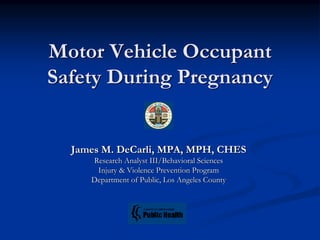
Seat Belt Safety for Pregnant Women
- 1. Motor Vehicle Occupant Safety During Pregnancy James M. DeCarli, MPA, MPH, CHES Research Analyst III/Behavioral Sciences Injury & Violence Prevention Program Department of Public, Los Angeles County
- 2. Should You Wear Your Seat Belt While Pregnant? Yes, always wear a seat belt. Wearing your seat belt protects you and your baby. The most common reason a fetus dies after a car crash is because the mother dies. Be sure to wear your seat belt correctly: The lap and shoulder belts keep you from being thrown from the car. The shoulder strap also keeps the pressure of your body off of the baby after a crash. You should wear a seat belt no matter where you sit in the car.
- 3. Motor Vehicle Occupant Injuries The leading cause of death for US residents between the ages of 15 and 44 is motor vehicle accidents. Pregnant women and their babies are particularly vulnerable to complications associated with motor vehicle accidents. Depending upon the severity of the trauma, women may be at risk for miscarriage, preterm labor, premature rupture of the membranes, and placental separation (abruption), as well as complications sustained from blood clots, fractures, and internal injuries to vital organs. The stress and anxiety encountered after such trauma is frightening for both the woman and her family.
- 4. Motor Vehicle Occupant Injuries Studies show that only 68 percent of pregnant women reported using seat belts correctly (Pearlman, 1996). Additionally, nearly 20% stated that they rarely or never used seat belts during their pregnancy. Many women have concerns about how to wear a seat belt when they're pregnant — and with good reason! When lap belts are improperly worn (over the dome of the uterus), they can significantly increase pressure on the baby and may possibly lead to fetal injury.
- 5. Anatomic Changes During Pregnancy 1st Trimester: Uterus is thick walled Provide considerable fetal protection 2nd Trimester: Uterus is more exposed But fetus is mobile and cushioned by amniotic fluid 3RD Trimester: Uterus is large and thin walled Less fetal protection Head in pelvis (exposed to pelvic injury)
- 6. Crash Impact Sequence: Relationship between body motion, uterine pressure & seat belt tension
- 7. Seat Belt Use During Pregnancy It has been shown that correct seat belt use significantly reduces both maternal and fetal morbidity and mortality following motor vehicle accidents. The American Medical Association and the American College of Obstetricians and Gynecologists recommend pregnant women always wear seat belts while traveling. Pregnant women wearing safety restraints while in motor vehicle crashes have lower rates of personal injury, and of fetal injury and fetal death, than women who aren't buckled up when in a crash.* *Hyde LK, et al. (2003). Effect of motor vehicle crashes on adverse fetal outcomes. Obstetrics and Gynecology, 102(2): 279–286.
- 8. Correct & Incorrect Use Remember that the Lap Belt should never be positioned on the abdomen, rather on the lap below the abdomen. The Shoulder Belt must never be placed behind or under the arm, but rather diagonally between the breasts.
- 9. Correct Seat Belt Use The lap strap should go under your belly, across your hips, and flat as possible on your thighs. The shoulder strap should go between your breasts, and off to the side of your belly. The seat belt should fit snugly.
- 10. Air Bags Air bags are safe and can protect the mother from head injury and the unborn child from injury. The air bags in your car should never be turned off because you are pregnant. Airbags are not a substitute for a seat belt, so always wear your seat belt even if your car has air bags. Remember, both air bags and seat belts work together to protect both the mother and the unborn child in a crash. During a crash without a seat belt, a pregnant women can be thrown into a opening air bag (approximately 200mph). Such a force can injury or kill the mother and her unborn child)
- 11. Safest Seat Location as Passenger If you are not Driving, the safety location to be seated when pregnant is in the back seat. Injuries from car crashes tend to be less serious to people who are sitting in the back seat, again when buckled up properly. However where a mother sits has not been shown to affect the safety of an unborn baby in a crash. But rear seat location is safest overall.
- 12. Seating Adjustment If you are driving, move the front seat as far back as possible Your breastbone should be at least 10 inches form the steering wheel or dashboard. As your abdomen grows during pregnancy, more the seat back to keep as much distance as possible (but safe enough, so your feet can operate the vehicle pedals effectively)
- 13. If you are in a car crash If you are in a car crash, you should see your doctor right away, even if you think you are not hurt. Most injuries to the baby happen within a few hours after a crash. Your doctor needs to check you and your baby as soon as possible after a crash, especially if you are more than six months pregnant. If right after the crash, you have any of the following, call 911: Pain in your belly Blood or fluid leaking from your vagina Contractions
- 14. Preventive Resources Injury & Violence Prevention Program (IVPP) Website www.ph.lacounty.gov/ivpp National Highway Traffic Safety Administration [www.nhtsa.dot.gov] Questions/Comments: jdecarli@ph.lacounty.gov (213) 351-7888